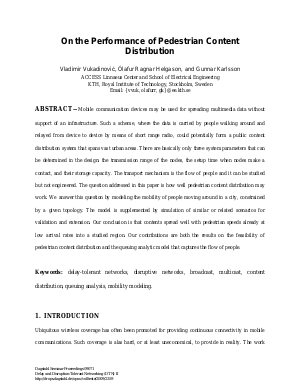On the Performance of Pedestrian Content Distribution
Authors Gunnar Karlsson, Olafur Ragnar Helgason, Vladimir Vukadinovic
-
Part of:
Volume:
Dagstuhl Seminar Proceedings, Volume 9071
Part of: Series: Dagstuhl Seminar Proceedings (DagSemProc) - License:
 Creative Commons Attribution 4.0 International license
Creative Commons Attribution 4.0 International license
- Publication Date: 2009-12-16
File

PDF
DagSemProc.09071.3.pdf
- Filesize: 0.56 MB
- 23 pages
Document Identifiers
Subject Classification
Keywords
- Content distribution
- mobile peer-to-peer
- ad hoc network
- wireless network
- mobile communication
Metrics
- Access Statistics
-
Total Accesses (updated on a weekly basis)
0Document
0Metadata
Abstract
Mobile communication devices may be used for spreading multimedia data without support of an infrastructure. Such a scheme, where the data is carried by people walking around and relayed from device to device by means of short range radio, could potentially form a public content distribution system that spans vast urban areas. There are basically only three system parameters that can be determined in the design: the transmission range of the nodes, the setup time when nodes make a contact, and their storage capacity. The transport mechanism is the flow of people and it can be studied but not engineered. The question addressed in this paper is how well pedestrian content distribution may work. We answer this question by modeling the mobility of people moving around in a city, constrained by a given topology. The model is supplemented by simulation of similar or related scenarios for validation and extension. Our conclusion is that contents spread well with pedestrian speeds already at low arrival rates into a studied region. Our contributions are both the results on the feasibility of pedestrian content distribution and the queuing analytic model that captures the flow of people.
Cite As Get BibTex
Gunnar Karlsson, Olafur Ragnar Helgason, and Vladimir Vukadinovic. On the Performance of Pedestrian Content Distribution. In Delay and Disruption-Tolerant Networking (DTN) II. Dagstuhl Seminar Proceedings, Volume 9071, pp. 1-23, Schloss Dagstuhl – Leibniz-Zentrum für Informatik (2009)
https://doi.org/10.4230/DagSemProc.09071.3
BibTex
@InProceedings{karlsson_et_al:DagSemProc.09071.3,
author = {Karlsson, Gunnar and Helgason, Olafur Ragnar and Vukadinovic, Vladimir},
title = {{On the Performance of Pedestrian Content Distribution}},
booktitle = {Delay and Disruption-Tolerant Networking (DTN) II},
pages = {1--23},
series = {Dagstuhl Seminar Proceedings (DagSemProc)},
ISSN = {1862-4405},
year = {2009},
volume = {9071},
editor = {Kevin Fall and Cecilia Mascolo and J\"{o}rg Ott and Lars Wolf},
publisher = {Schloss Dagstuhl -- Leibniz-Zentrum f{\"u}r Informatik},
address = {Dagstuhl, Germany},
URL = {https://drops.dagstuhl.de/entities/document/10.4230/DagSemProc.09071.3},
URN = {urn:nbn:de:0030-drops-23597},
doi = {10.4230/DagSemProc.09071.3},
annote = {Keywords: Content distribution, mobile peer-to-peer, ad hoc network, wireless network, mobile communication}
}
